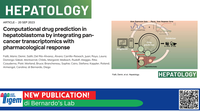Authors: Failli, Mario; Demir, Salih; Del Río-Álvarez, Álvaro; Carrillo-Reixach, Juan; Royo, Laura; Domingo-Sàbat, Montserrat; Childs, Margaret; Maibach, Rudolf; Alaggio, Rita; Czauderna, Piotr; Morland, Bruce; Branchereau, Sophie; Cairo, Stefano; Kappler, Roland; Armengol, Carolina; di Bernardo, Diego
Year: 2023
Sources: Hepatology
Abstract:
Hepatoblastoma (HB) is the main paediatric liver cancer, but it is a very rare disease. Despite significant improvements in the treatment of children diagnosed with HB, limited treatment options exist for patients with advanced tumours. Besides, survivors generally have long-term adverse effects derived from treatment such as ototoxicity, cardiotoxicity, delayed growth, and secondary tumours. Accordingly, there is an urgent need to define new and efficient therapeutic strategies for patients with HB. Computational methods to predict drug sensitivity from a tumour’s transcriptome have been successfully applied for some common adult malignancies, but specific efforts in paediatric cancers are lacking because of paucity of data. In this study, we computationally screened the efficacy of drugs in HB patients with the aggressive C2 subtype and poor clinical outcome starting from their transcriptome. Our method utilized publicly available collections of pan-cancer transcriptional profiles and drug responses across 36 tumour types and 495 compounds. The drugs predicted to be most effective were experimentally validated using patient-derived xenograft (PDX) models of HB grown in vitro and in vivo. We thus identified two CDK9 inhibitors, alvocidib and dinaciclib as potent HB growth inhibitors for the high-risk C2 molecular subtype. We also found that in a cohort of 46 patients with HB, high CDK9 tumour expression was significantly associated with poor prognosis. Our work proves the usefulness of computational methods trained on pan-cancer datasets to reposition drugs in rare paediatric cancers such as HB, and to help clinicians in choosing the best treatment options for their patients.
Category: journals

